Deza M.M., Laurent M. Geometry of Cuts and Metrics
Подождите немного. Документ загружается.

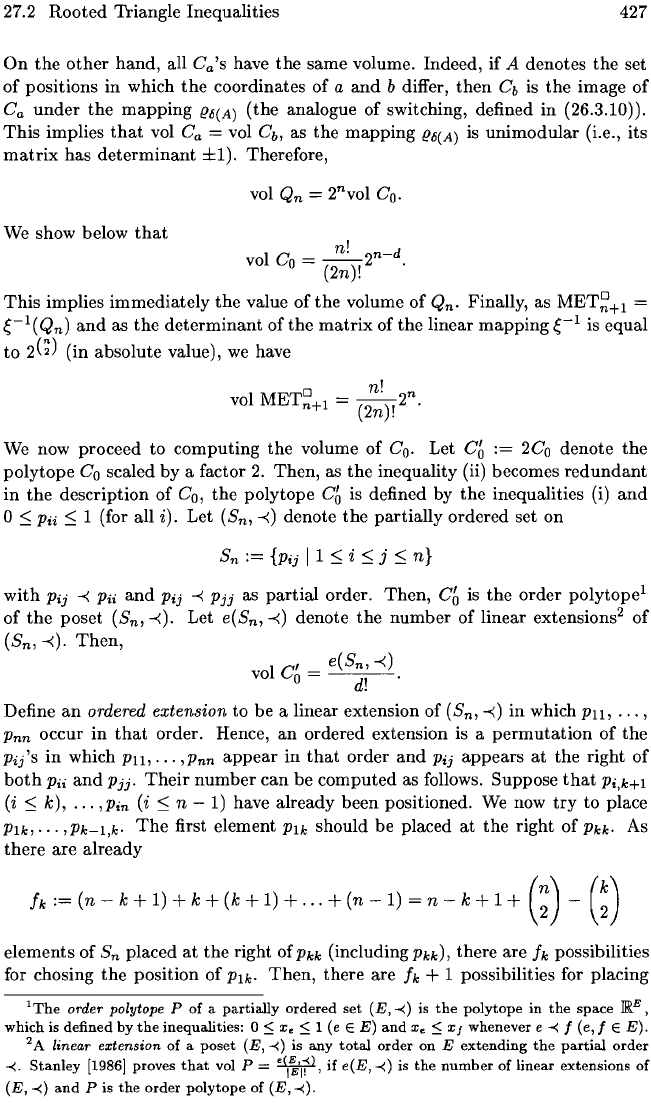
27.2
Rooted
Triangle Inequalities
427
On
the
other
hand,
all
Ca's
have
the
same volume. Indeed,
if
A denotes
the
set
of
positions
in
which
the
coordinates
of
a
and
b differ,
then
Cb
is
the
image
of
C
a
under
the
mapping
f!6(A)
(the analogue of switching, defined
in
(26.3.10)).
This
implies
that
vol C
a
= vol C
b
,
as
the
mapping
f!6(A) is
unimodular
(i.e., its
matrix
has
determinant
±1). Therefore,
We show below
that
n!
n-d
vol
Co
=
-(
),2 .
2n.
This
implies immediately
the
value
of
the
volume
of
Qn- Finally, as
MET~+l
=
~-l(Qn)
and
as
the
determinant
of
the
matrix
of
the
linear
mapping
~-l
is equal
to
2m
(in absolute value),
we
have
o n! n
vol METn+l =
-(
),2
2n.
We now proceed to computing
the
volume
of
Co.
Let
Co
:=
2Co
denote
the
polytope
Co
scaled by a factor
2.
Then, as
the
inequality (ii) becomes
redundant
in
the
description
of
Co,
the
polytope
Co
is defined by
the
inequalities (i)
and
o S Pii S 1 (for all i). Let
(Sn,
-<)
denote
the
partially
ordered set on
Sn
:=
{Pij
11
SiS
j S
n}
with
Pij
-<
Pii
and
Pij
-<
Pjj
as
partial
order.
Then,
Co
is
the
order
polytope
l
of
the
poset
(Sn,
-<).
Let
e(Sn,
-<)
denote
the
number
of
linear extensions
2
of
(Sn,
-<).
Then,
1
C
' _
e(Sn,
-<)
vo
0-
d!
.
Define
an
ordered
extension
to be a linear extension
of
(Sn,
-<)
in
which
Pll,
...
,
Pnn
occur
in
that
order. Hence,
an
ordered extension is a
permutation
of
the
Pij'S
in
which
Pll,
...
,Pnn
appear
in
that
order
and
Pij
appears
at
the right
of
both
Pii
and
Pjj.
Their
number
can
be
computed
as follows. Suppose
that
Pi,k+l
(i S k),
...
,Pin
(i S n -
1)
have already been positioned.
We
now
try
to place
Plk,'"
,Pk-l,k·
The
first element
Plk
should be placed
at
the
right
of
Pkk. As
there
are
already
fk
:=
(n
- k +
1)
+ k + (k +
1)
+ ... +
(n
-
1)
= n - k + 1 +
(;)
-
G)
elements of
Sn
placed
at
the
right of Pkk (including Pkk), there are
fk
possibilities
for chosing
the
position
of
Plk.
Then,
there are
fk
+ 1 possibilities for placing
1
The
order polytope P
of
a
partially
ordered
set
(E,
-<)
is
the
polytope
in
the
space
~E,
which
is
defined
by
the
inequalities:
0
::5
x.
::5
1
(e
E E)
and
x.
::5
x f
whenever
e
-<
f (e,
fEE).
2 A linear extension
of
a
poset
(E,
-<)
is
any
total
order
on
E
extending
the
partial
order
-<.
Stanley
[1986] proves
that
vol P =
'(I~'I~)'
if
e(E,
-<)
is
the
number
of
linear
extensions
of
(E,
-<)
and
P is
the
order
polytope
of
(E,
-<).
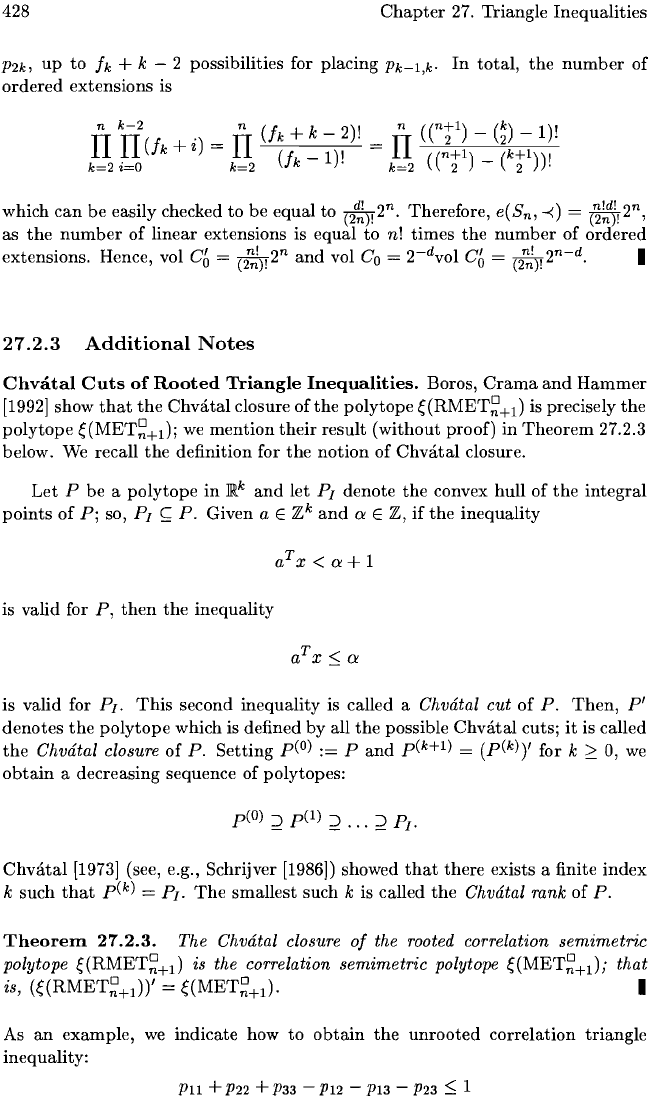
428
Chapter
27. Triangle Inequalities
P2k,
up
to
!k
+ k - 2 possibilities for placing
Pk-l,k.
In
total,
the
number
of
ordered
extensions is
which
can
be
easily checked
to
be
equal to
(2~)!2n.
Therefore,
e(Sn,
-<)
=
(~~j!2n,
as
the
number
of
linear
extensions is equal
to
n!
times
the
number
of
ordered
. H I C
f
-
n! 2
n
die
-
2-
d
I C
f
-
n! 2
n
-
d
I
extenSIOns. ence,
vo
a - (2n)!
an
vo a - vo a - (2n)! .
27.2.3
Additional
Notes
Chvatal
Cuts
of
Rooted
Triangle
Inequalities.
Boros,
Crama
and
Hammer
[1992]
show
that
the
Chvatal
closure
ofthe
polytope
~(RMET~+1)
is precisely
the
polytope
~(MET~+1);
we
mention
their
result
(without
proof)
in
Theorem
27.2.3
below. We recall
the
definition for
the
notion
of
Chvatal
closure.
Let
P
be
a
polytope
in
m,k
and
let
PI
denote
the
convex hull of
the
integral
points
of
P;
so,
PI
S;;;
P.
Given a E
7/.,k
and
0'
E
7/."
if
the
inequality
is valid for
P,
then
the
inequality
is valid for
PI.
This
second inequality is called a Chvlital cut
of
P.
Then,
pf
denotes
the
polytope
which is defined
by
all
the
possible
Chvatal
cuts;
it
is called
the
Chvlital closure
of
P.
Setting
pea)
:=
P
and
p(k+1)
=
(p(k))f
for k
2:
0, we
obtain
a decreasing sequence of polytopes:
p(O)
;;?
pel)
;;?
...
;;?
PI.
Chvatal
[1973]
(see, e.g., Schrijver [1986]) showed
that
there
exists a finite
index
k such
that
p(k)
=
PI.
The
smallest such k is called
the
Chvlital rank of
P.
Theorem
27.2.3.
The Chvlital closure
of
the rooted correlation
semimetric
polytope
~(RMET~+l)
is the correlation semimetric polytope
~(MET~+1);
that
is,
(~(RMET~+l))'
=
~(MET~+l)'
I
As
an
example,
we
indicate
how
to
obtain
the
unrooted
correlation
triangle
inequality:
Pn
+
P22
+
P33
-
P12
-
P13
-
P23
::; 1
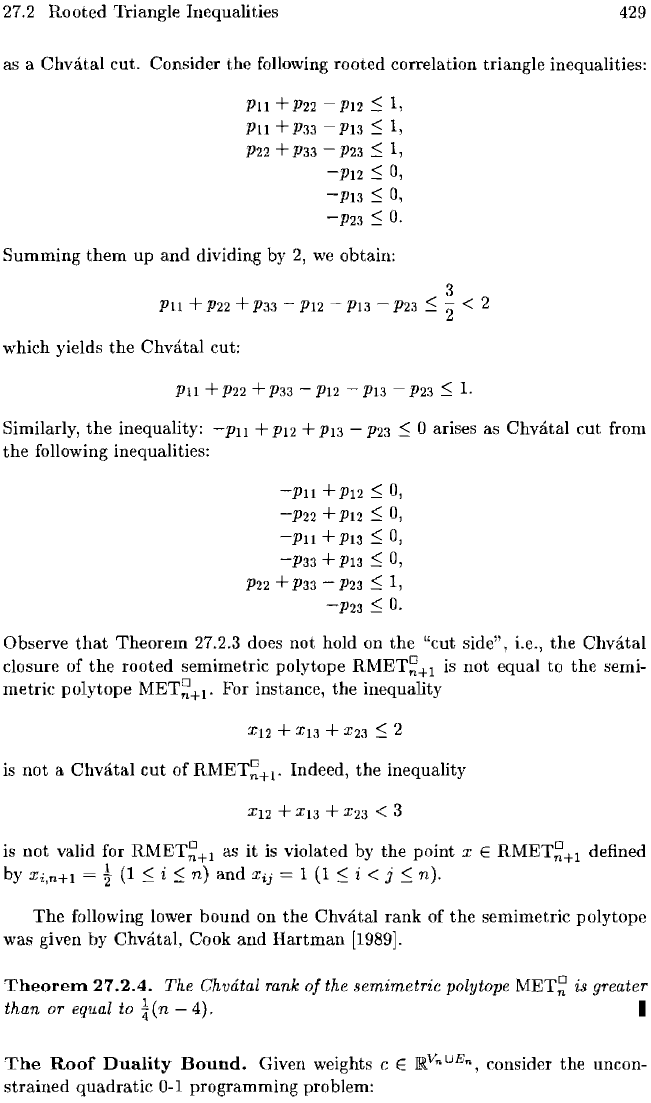
27.2 Rooted Triangle Inequalities
429
as a
Chvatal
cut. Consider the following rooted correlation triangle inequalities:
Pll
+ P22
PI2
S 1,
PIl
+
P33
PI3
S 1,
P22 +
P33
P23 S 1,
-P12
SO,
-P13
SO,
-P23
SO.
Summing
them
up
and
dividing by
2,
we
obtain:
3
Pll
+ P22 + P33
PI2
PI3
P23 S 2 < 2
which yields
the
Chvatal cut:
Pll
+ P22 + P33
PI2
PI3
P23 S 1.
Similarly,
the
inequality:
-Pll
+
PI2
+
PI3
P23 S 0 arises as Chvatai
cut
from
the
following inequalities:
-PH
+
PI2
S
0,
-Pn
+ PI:! S 0,
-PH
+
PI3
S 0,
-P33
+
PI3
S 0,
P22 +
P33
- P23 S 1,
-P23
SO.
Observe
that
Theorem 27.2.3 does
not
hold on
the
"cut side", i.e.,
the
Chvatal
closure of
the
rooted semimetric polytope
RMET~+l
is
not
equal to
the
semi-
metric polytope
MET~+l'
.For
instance,
the
inequality
is
not
a
Chvatal
cut
of
RMET~+l'
Indeed,
the
inequality
is
not
valid for
R~vlE:T~:-l-
by
Xi,n+l
~
(1
SiS
XI2
+X13 +X23
< 3
as
it
is
violated by
the
point x E
RMET~+l
defined
andxij
l(lSi<jSn).
The
following lower
bound
on
the
Chvatal
rank
of
the
semimetric polytope
was given by Chvatai, Cook
and
Hartman
[1989J.
Theorelll
27.2.4.
The Chvcital rank
of
the
semimetric
polytope
MET~
is greater
than
or equal to
~(n
4). I
The
Roof
Duality
Bound.
Given weights c E
lRV"UE",
consider
the
uncon-
strained
quadratic
0-1
programming problem:
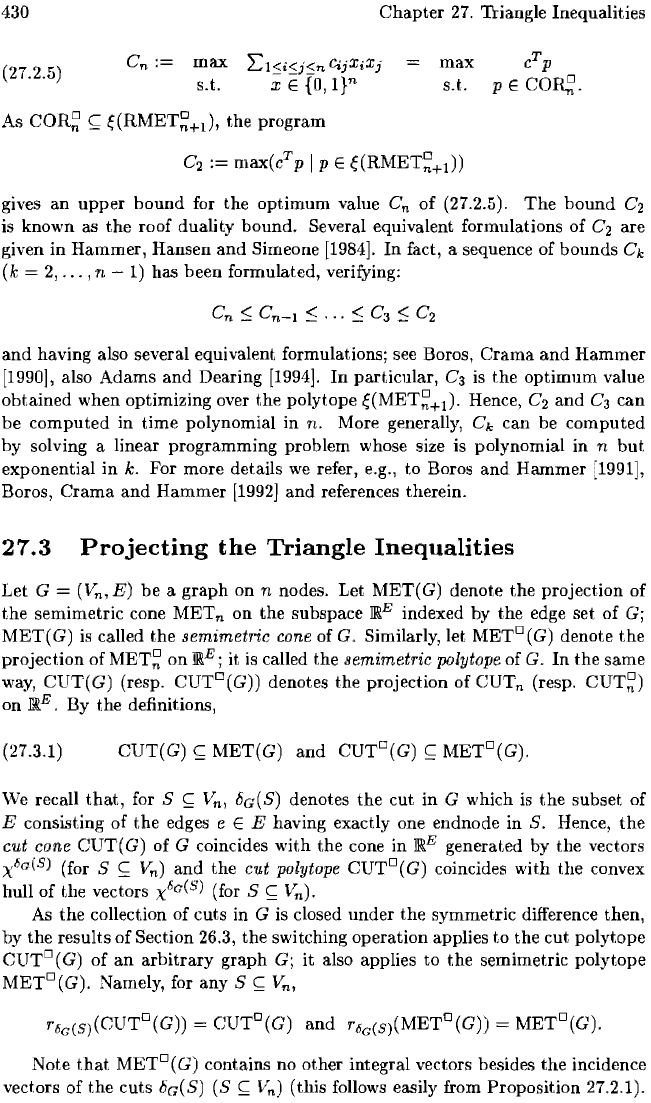
430
Chapter
27. Triangle Inequalities
(27.2.5)
max
Ll~i~j~n
CijX;Xj
s.t. x E
{O,
l}n
max cTp
s.t. pEcoR;;.
As
COR~
~
e(RMET~+1)'
the program
C2
:=
max(c
T
pip
E
e(RMET~+1))
gives
an
upper
bound
for the optimum value C
n
of (27.2.5).
The
bound
C2
is known as the roof duality bound. Several equivalent formulations of
C2
are
given in Hammer, Hansen and Simeone
[1984]. In fact, a sequence of bounds
Ck
(k =
2,
...
,n
-
1)
has been formulated, verifying:
and
having also several equivalent formulations; see Boros, Crama and Hammer
[19901,
also Adams
and
Dearing [1994]. In particular,
C3
is
the optimum value
obtained when optimizing over the polytope
e(MET~+l)'
Hence,
C2
and C
3
can
be
computed in time polynomial in n. More generally,
Ck
can be computed
by solving a linear programming problem whose size
is
polynomial
in
n
but
exponential in k. For more details
we
refer, e.g., to Boros and Hammer [1991],
Boros,
Crama
and Hammer [1992]
and
references therein.
27.3
Projecting
the
Triangle
Inequalities
Let G = (Vn,
E)
be
a graph on n nodes. Let MET(G) denote the projection of
the semi metric cone METn
on
the subspace RE indexed by the edge set
of
G;
MET(G)
is
called the semimetric cone of G. Similarly, let METD(G) denote
the
projection
of
MET~
on
RE; it is called the semimetric polytope of G.
In
the same
way,
CUT(G) (resp. CUTD(G)) denotes the projection
of
CUTn (resp.
CUT~)
on
RE.
By the definitions,
(27.3.1)
CUT(G)
~
MET(G) and CUTD(G)
~
METD(G).
We recall
that,
for 5
~
V
nl
oa(5) denotes the cut in G which
is
the
subset of
E consisting of
the
edges e E E having exactly one endnode in
5.
Hence,
the
cut
cone CUT( G) of G coincides with the cone in RE generated
by
the vectors
Xo
o
(8)
(for 5
~
V
n
) and
the
cut polytope CUTD(G) coincides with the convex
hull of the vectors
X
oo
(8)
(for 5
~
V
n
).
As
the collection of cuts in G
is
closed under the symmetric difference then,
by
the
results
of
Section 26.3, the switching operation applies to
the
cut polytope
CUT
D
(G) of
an
arbitrary graph G; it also applies to
the
semimetric polytope
METD(G). Namely, for any 5
~
V
n
,
Note
that
METD(G) contains no other integral vectors besides
the
incidence
vectors
of
the cuts oa(5)
(5
~
V
n
)
(this follows easily from Proposition 27.2.1).
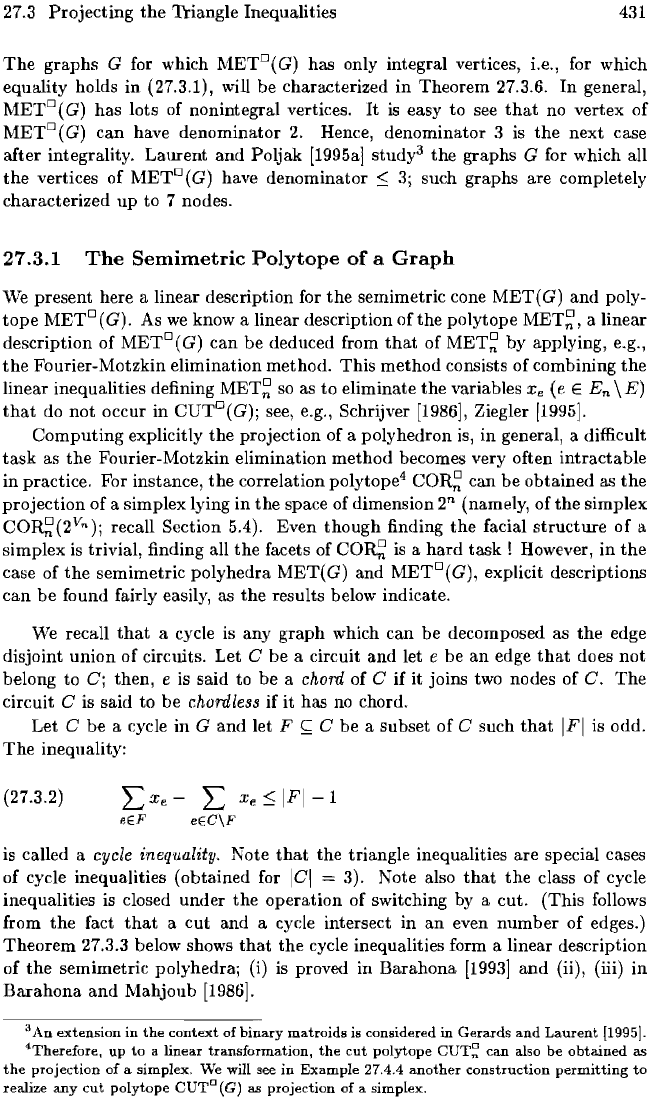
27.3 Projecting
the
Triangle Inequalities
431
The
graphs G for which METD(G) has only integral vertices, i.e., for which
equality holds
in
(27.3.1), will be characterized
in
Theorem 27.3.6.
In
general,
METD
(G) has lots of nonintegral vertices.
It
is
easy to see
that
no vertex of
METD(G)
can
have denominator
2.
Hence, denominator 3
is
the
next case
after integrality. Laurent and Poljak
[1995a]
stud
y3 the graphs G for which all
the
vertices of METO(G) have denominator:::;
3;
such graphs are completely
characterized
up
to 7 nodes.
27.3.1
The
Semimetric
Polytope
of
a Graph
\Ve
present here a linear description for
the
semimetric cone
MET(
G)
and
poly-
tope
METD (G). As
we
know a linear description of the polytope
MET~,
a linear
description of METD(G)
can
be deduced from
that
of
MET~
by applying, e.g.,
the
Fourier-Motzkin elimination method. This method consists of combining
the
linear inequalities defining
MET~
so
as to eliminate
the
variables Xe
(e
E En \
E)
that
do
not
occur in CUTD(G); see, e.g., Schrijver
[1986],
Ziegler
[1995].
Computing explicitly the projection of a polyhedron is, in general, a difficult
task
as
the
Fourier-Motzkin elimination method becomes very often intractable
in practice. For instance,
the
correlation polytope
4
COR~
can be obtained as
the
projection of a simplex lying
in
the space of dimension 2
n
(namely,
of
the
simplex
COR~(2Vn);
recall Section 5.4). Even though finding
the
facial
structure
of
a
simplex
is
trivial, finding all
the
facets of
CO~
is a
hard
task!
However,
in
the
case of
the
semimetric polyhedra MET(G) and METD(G), explicit descriptions
can
be found fairly easily, as
the
results below indicate.
We
recall
that
a cycle is any
graph
which
can
be decomposed as
the
edge
disjoint union
of
circuits. Let C be a circuit
and
let e be
an
edge
that
does not
belong to C; then, e is said to
be
a chord of C if
it
joins two nodes
of
C.
The
circuit C is said to be
chord
less
if
it
has no chord.
Let C be a cycle in G
and
let F
~
C
be
a subset
of
C such
that
IFI
is odd.
The
inequality:
(27.3.2)
Xe
L
xe:::;
IFI
- 1
eEC\F
is called a cycle inequality. Note
that
the triangle inequalities are special cases
of
cycle inequalities (obtained for
IC!
= 3). Note also
that
the
class of cycle
inequalities is closed under the operation of switching by a cut. (This follows
from
the
fact
that
a cut and a cycle intersect in
an
even number of edges.)
Theorem 27.3.3 below shows
that
the
cycle inequalities form a linear description
of
the
semimetric polyhedra; (i) is proved in Barahona
[1993]
and (ii), (iii) in
Barahona
and
Mahjoub
[1986].
extension
in
the
context
of
binary
matroids
is considered in
Gerards
and
Laurent
[19951.
4Therefore,
up
to
a linear
transformation,
the
cut
polytope
CUT~
can
also
be
obtained
as
the
projection
of
a simplex.
We
will see
in
Example
27.4.4
another
construction
permitting
to
realize
any
cut
polytope
CUTD(G) as projection of a simplex.
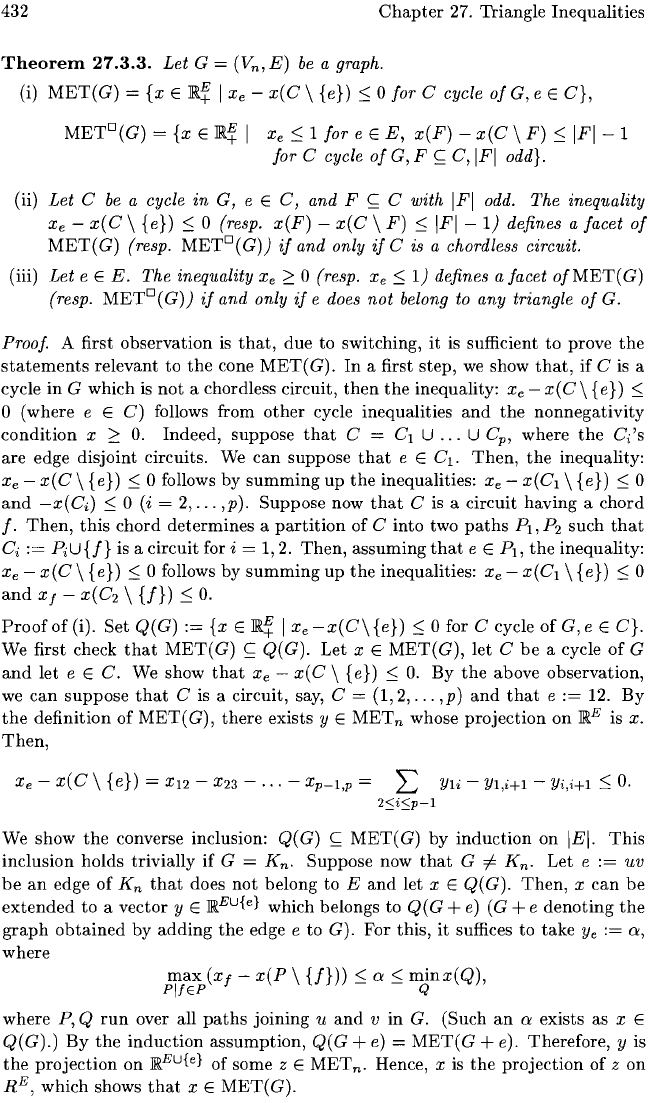
432
Chapter
27. Triangle
Inequalities
Theorem
27.3.3.
Let G =
(Vn'
E)
be
a graph.
(i)
MET(G)
=
{x
E
ffi.~
I
Xe
-
x(C\
{e})::; 0 for C cycle
ofG,e
E
C},
METD(G)
=
{x
E
ffi.~
I xe::; 1 for e E
E,
x(F)
-
x(C
\
F)
::;
IFI-1
for C cycle
of
G, F
~
c,
IFI
odd}.
(ii) Let C
be
a cycle in G, e E
C,
and F
~
C with
IFI
odd.
The inequality
Xe
-
x(C
\ {e})
::;
0 (resp.
x(F)
-
x(C
\
F)
::;
IFI-
1)
defines a facet
of
MET
(G) (resp.
METD(G))
if
and only
if
C is a chordless circuit.
(iii) Let e E
E.
The inequality
xe::::
0 (resp. xe::;
1)
defines a facet
of
MET
(G)
(resp.
METD
(G))
if
and only
if
e
does
not belong
to
any triangle
of
G.
Proof. A first observation is
that,
due
to
switching,
it
is sufficient
to
prove
the
statements
relevant
to
the
cone
MET(G).
In
a first
step,
we
show
that,
if
C
is
a
cycle in G which
is
not
a chordless circuit,
then
the
inequality:
Xe
- x( C \ {e})
::;
o (where e E
C)
follows from
other
cycle inequalities
and
the
nonnegativity
condition
x
::::
o.
Indeed, suppose
that
C = C
l
U
...
U C
p
,
where
the
C;'s
are edge disjoint circuits. We
can
suppose
that
e E C
l
.
Then,
the
inequality:
Xe
-
x(
C \ {e})
::;
0 follows
by
summing
up
the
inequalities:
Xe
-
x(
C
1
\
{e})
::;
0
and
-x(C
i
)
::;
0 (i = 2,
...
,p). Suppose now
that
C is a circuit having a
chord
f.
Then,
this
chord
determines
a
partition
of C into two
paths
PI, P
2
such
that
Ci
:=
PiU{f}
is a circuit for i =
1,2.
Then,
assuming
that
e E PI,
the
inequality:
Xe
-
x(
C \ {e})
::;
0 follows
by
summing
up
the
inequalities:
Xe
-
x(
C
l
\
{e})
::;
0
and
xf
-
x(C
2
\
{f})
::;
o.
Proof
of
(i).
Set
Q(G):=
{x
E
ffi.~
I
xe-x(C\{e})::;
0 for C cycle
ofG,e
E
C}.
We first check
that
MET(G)
~
Q(G).
Let
x E
MET(G),
let C
be
a cycle
of
G
and
let e E
C.
We show
that
Xe
-
x(C
\ {e})
::;
o.
By
the
above observation,
we
can
suppose
that
C is a circuit, say, C =
(1,2,
...
,p)
and
that
e
:=
12.
By
the
definition of
MET(G),
there
exists Y E
METn
whose
projection
on
ffi.E
is x.
Then,
Xe
-
x(
C \ {e}) = X12 -
X23
-
...
- Xp-l,p = L
Yli
-
Yl,i+l
-
Yi,i+l
::;
o.
2:C;i:C;p-l
We show
the
converse inclusion: Q(G)
~
MET(G)
by
induction
on
lEI.
This
inclusion holds
trivially
if
G = Kn. Suppose now
that
G
=1=
Kn-
Let
e
:=
uv
be
an
edge
of
Kn
that
does
not
belong
to
E
and
let x E Q(G).
Then,
x
can
be
extended
to
a vector Y E ffi.EU{e} which belongs
to
Q(G
+
e)
(G + e
denoting
the
graph
obtained
by
adding
the
edge e
to
G). For this,
it
suffices
to
take
Ye
:=
a,
where
max
(xf
-
x(P
\
{f}))
::;
a::;
minx(Q),
PifEP
Q
where
P,
Q
run
over all
paths
joining u
and
v in G. (Such
an
a exists as x E
Q(G).)
By
the
induction
assumption,
Q(G
+ e) =
MET(G
+ e). Therefore, Y is
the
projection
on
ffi.EU{e} of some z E
METn.
Hence, x is
the
projection
of z
on
R
E
,
which shows
that
x E
MET(G).
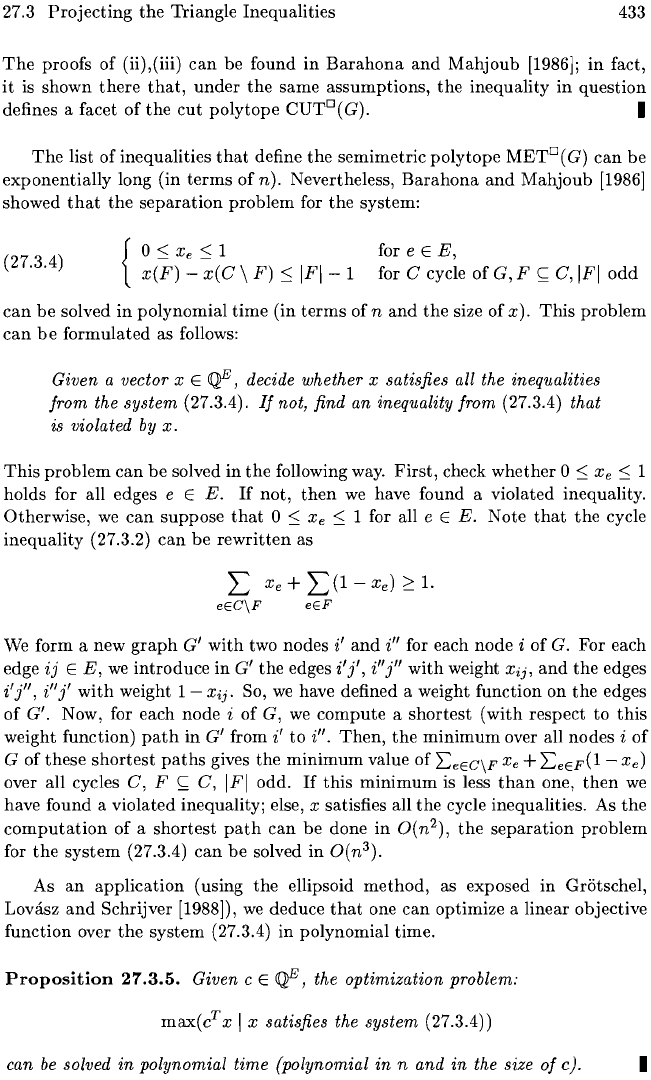
27.3
Projecting
the
Triangle Inequalities
433
The
proofs
of
(ii),(iii)
can
be found
in
Barahona
and
Mahjoub
[1986];
in
fact,
it
is
shown
there
that,
under
the
same
assumptions,
the
inequality
in
question
defines a facet
of
the
cut
polytope
CUTD(G). I
The
list
of
inequalities
that
define
the
semimetric
polytope
METD (G)
can
be
exponentially
long
(in
terms
of
n). Nevertheless,
Barahona
and
Mahjoub
[1986]
showed
that
the
separation
problem
for
the
system:
(27.3.4)
{
0
<
Xe
< 1
x(F)
-
x(O
\
F)
:S
IFI-1
for e E
E,
for ° cycle
of
G, F
<;;;
0,
IFI
odd
can
be
solved
in
polynomial
time
(in
terms
of
n
and
the
size
of
x).
This
problem
can
be
formulated
as follows:
Given a vector x
E
cry;
, decide whether x satisfies all the inequalities
from the
system
(27.3.4).
If
not, find an inequality from (27.3.4) that
is violated by
x.
This
problem
can
be
solved
in
the
following way.
First,
check
whether
0
:S
Xe
:S
1
holds
for all edges e E
E.
If
not,
then
we
have found a violated inequality.
Otherwise,
we
can
suppose
that
0
:S
Xe
:S
1 for all e E
E.
Note
that
the
cycle
inequality
(27.3.2)
can
be
rewritten
as
2::
Xe
+
2::(1-
Xe)
:::::
l.
eEC\F
eEF
We form a
new
graph
G'
with
two nodes
i'
and
i"
for each
node
i
of
G. For each
edge
ij
E
E,
we
introduce
in
G'
the
edges
i'j',
i"j"
with
weight
Xij,
and
the
edges
i'
j",
i"
j'
with
weight 1 -
Xij.
So,
we
have defined a weight
function
on
the
edges
of
G'. Now, for each
node
i
of
G,
we
compute
a
shortest
(with
respect
to
this
weight function)
path
in
G'
from
i'
to
i".
Then,
the
minimum
over all
nodes
i
of
G
of
these
shortest
paths
gives
the
minimum
value
of
~eEC\F
Xe
+
~eEF(l-
Xe)
over all cycles
0,
F
<;;;
0,
IFI
odd.
If
this
minimum
is less
than
one,
then
we
have found a
violated
inequality; else, x satisfies all
the
cycle inequalities. As
the
computation
of
a
shortest
path
can
be
done
in
O(n
2
),
the
separation
problem
for
the
system
(27.3.4)
can
be
solved
in
O(n
3
).
As
an
application
(using
the
ellipsoid
method,
as
exposed
in
Gri:itschel,
Lovasz
and
Schrijver [1988]),
we
deduce
that
one
can
optimize
a linear objective
function
over
the
system
(27.3.4)
in
polynomial
time.
Proposition
27.3.5.
Given c E
cry;,
the optimization problem:
max(
c
T
x I x satisfies the
system
(27.3.4))
can
be
solved
in
polynomial
time
(polynomial
in
n and
in
the size
of
c). I
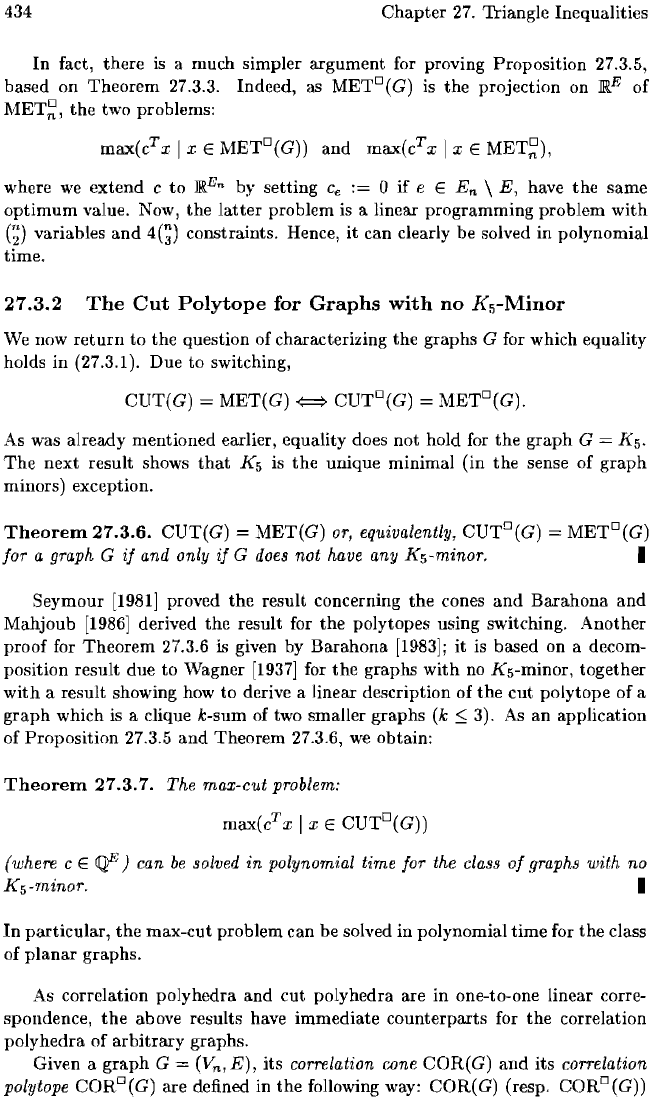
434
Chapter 27. Triangle Inequalities
In
fact, there is a much simpler argument for proving Proposition 27.3.5,
based on Theorem 27.3.3. Indeed, as METD(G) is the projection on
.IRE
of
MET~,
the
two problems:
where
we
extend c
to
.IRE"
by setting C
e
:=
0 if e E En \ have the same
optimum
value. Now,
the
latter
problem is a linear programming problem
with
(;)
variables
and
4G)
constraints. Hence,
it
can clearly be solved in polynomial
time.
27.3.2
The
Cut
Polytope
for
Graphs
with
no
K5-Minor
We
now
return
to
the
question of characterizing
the
graphs G for which equality
holds in
(27.3.1). Due to switching,
CUT(G)
= MET(G)
¢:::}
CUTD(G) = METD(G).
As was already mentioned earlier, equality does not hold
for
the
graph G = K
5
•
The
next result shows
that
K5 is
the
unique minimal (in
the
sense of
graph
minors) exception.
Theorem
27.3.6.
CUT(G) MET(G) or, equivalently, CUTD(G) = METD(G)
for
a graph G
if
and only
if
G does not have any K
5
-minor. I
Seymour [1981J proved
the
result concerning the cones
and
Barahona and
Mahjoub
[1986] derived the result for
the
polytopes using switching. Another
proof for Theorem
27.3.6 is given
by
Barahona
[U}83]i
it
is based on a decom-
position result due to Wagner
[1937] for
the
graphs
with
no K5-minor, together
with
a result showing how
to
derive a linear description
of
the
cut
polytope
of
a
graph
which is a clique k-sum of two smaller graphs (k S 3). As
an
application
of Proposition
27.3.5
and
Theorem 27.3.6,
we
obtain:
Theorem
27.3.7.
The max-cut problem:
(where
c E
to!
) can
be
solved
in
polynomial time for the class
of
graphs with no
K
5
-minor. I
In
particular,
the
max-cut problem
can
be solved in polynomial
time
for
the
class
of
planar
graphs.
As correlation polyhedra
and
cut polyhedra are in one-to-one linear corre-
spondence,
the
above results have immediate counterparts for
the
correlation
polyhedra
of
arbitrary
graphs.
Given a
graph
G =
(Vn,E),
its
correlation cone COR(G)
and
its correlation
polytope
CORD(G) are defined in
the
following way: COR(G) (resp. CORD(G))
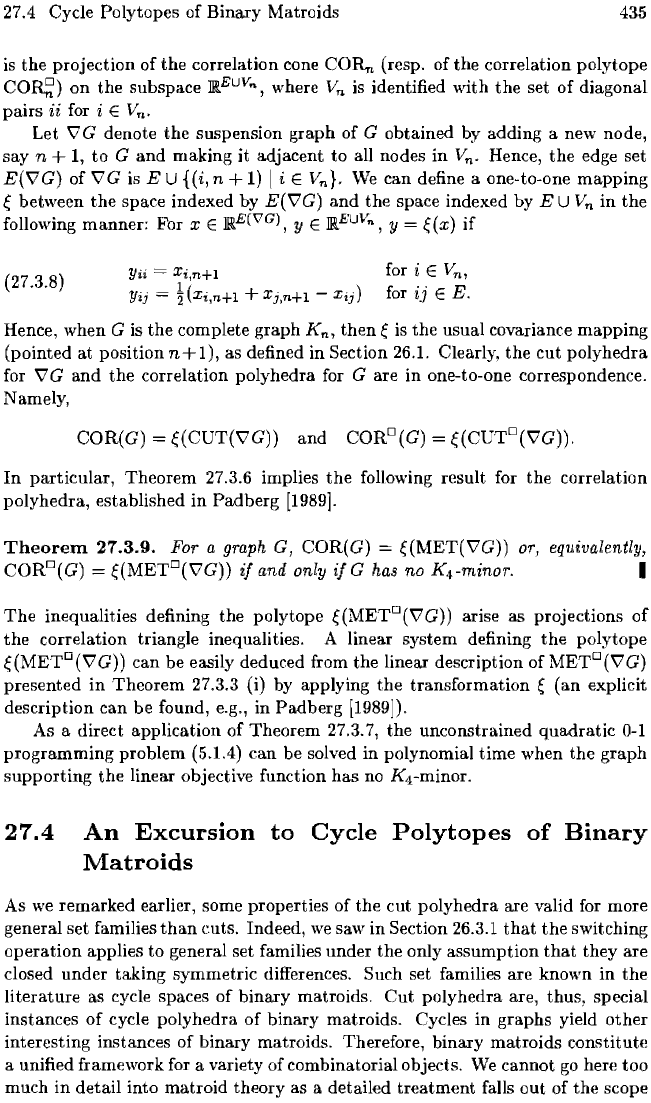
27.4 Cycle Polytopes of Binary Matroids
435
is
the
projection
of
the
correlation cone
COR,."
(resp. of
the
correlation polytope
CO~)
on
the subspace llt
EUV
""
where
Vn
is identified with
the
set
of
diagonal
pairs
ii
for i E V
n
•
Let
V'
G denote
the
suspension graph of G obtained by adding a new node,
say
n +
1,
to G
and
making
it
adjacent to all nodes
in
V
n
•
Hence, the edge set
E(V' G)
of
V'
G is E U { (i, n +
1)
liE
V
n
}.
We
can
define a one· to-one mapping
~
between
the
space indexed by E(V'G)
and
the space indexed by E U
Vn
in the
following manner: For
x E
lltE(VG),
y E llt
EUV
",
, Y
~(x)
if
(27.3.8)
Yii
Xi,n+I
Yij
=
~(Xi,n+I
+
Xj,n+l
Xij)
for i E V
n
,
for
ij
E E.
Hence, when G is
the
complete graph Kn,
then
~
is
the usual covariance mapping
(pointed
at
position n+ 1), as defined in Section 26.1. Clearly, the
cut
polyhedra
for
V'G
and the correlation polyhedra
for
G are in one-to-one correspondence.
Namely,
COR(G)
=
~(CUT(V'G»
and
CORD
(G)
~(GCTD(V'G).
In
particular, Theorem 27.3.6 implies
the
following result for the correlation
polyhedra, established in Padberg
[1989].
Theorem
27.3.9.
For a
graph
G, COR(G) =
~(MET(V'G»
or, equivalently,
CORD(G)
~(METD(V'G»
if
and only
ifG
has no K
4
-minor. I
The
inequalities defining
the
polytope
~(METD(V'G»
arise as projections
of
the
correlation triangle inequalities. A linear system defining
the
polytope
~(METD(V'G»
can
be easily deduced from
the
linear description
of
METD(V'G)
presented
in
Theorem 27.3.3 (i) by applying
the
transformation
~
(an explicit
description
can
be
found, e.g., in
Padberg
[1989]).
As a direct application
of
Theorem 27.3.7,
the
unconstrained quadratic
0-1
programming problem (5.1.4)
can
be solved in polynomial time when the graph
supporting
the
linear objective function has
no
K4-minor.
27.4
An
Excursion
to
Cycle
Polytopes
of
Binary
Matroids
As
we
remarked earlier, some properties of the
cut
polyhedra are valid
for
more
general set families
than
cuts. Indeed,
we
saw in Section 26.3.1
that
the
switching
operation
applies to general set families under the only assumption
that
they are
closed under taking symmetric differences. Such set families are known
in
the
literature
as cycle spaces of binary matroids.
Cut
polyhedra are, thus, special
instances
of
cycle polyhedra
of
binary matroids. Cycles
in
graphs yield
other
interesting instances of binary matroids. Therefore, binary matroids constitute
a unified framework for a variety of combinatorial objects.
We
cannot
go
here too
much
in
detail into matroid theory as a detailed treatment falls
out
of
the scope
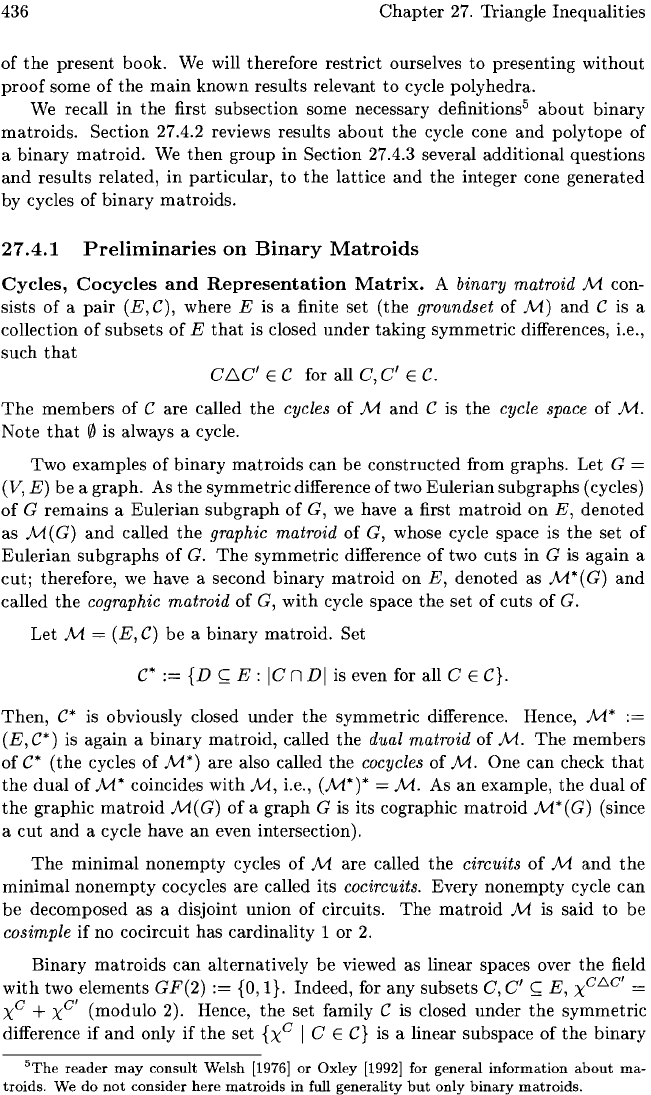
436
Chapter
27.
Triangle Inequalities
of
the
present
book. We will therefore
restrict
ourselves
to
presenting
without
proof
some
of
the
main
known results relevant
to
cycle
polyhedra.
We recall
in
the
first subsection some necessary definitions
5
about
binary
matroids.
Section 27.4.2 reviews results
about
the
cycle cone
and
polytope
of
a
binary
matroid.
We
then
group
in
Section 27.4.3 several
additional
questions
and
results
related,
in
particular,
to
the
lattice
and
the
integer cone
generated
by cycles of
binary
matroids.
27.4.1
Preliminaries
on
Binary
Matroids
Cycles,
Co
cycles
and
Representation
Matrix.
A binary matroid M con-
sists
of
a
pair
(E,C),
where E is a finite set
(the
groundset of
M)
and
C is a
collection
of
subsets
of
E
that
is closed
under
taking
symmetric
differences, i.e.,
such
that
CL.C'
E C for all C,
C'
E
C.
The
members
of
C are called
the
cycles
of
M
and
C is
the
cycle space
of
M.
Note
that
0 is always a cycle.
Two
examples
of
binary
matroids
can
be
constructed
from graphs. Let G =
(V,
E)
be
a
graph.
As
the
symmetric
difference of two
Eulerian
subgraphs
(cycles)
of
G
remains
a
Eulerian
subgraph
of
G,
we
have a first
matroid
on
E,
denoted
as
M(G)
and
called
the
graphic matroid
of
G, whose cycle space is
the
set
of
Eulerian
sub
graphs
of
G.
The
symmetric
difference
of
two
cuts
in G is
again
a
cut;
therefore, we have a second
binary
matroid
on
E,
denoted
as
M*(
G)
and
called
the
cographic matroid
of
G,
with
cycle space
the
set
of
cuts
of
G.
Let
M = (E,
C)
be
a
binary
matroid.
Set
C*
:=
{D
~
E:
IC n DI is even for all C E C}.
Then,
C* is obviously closed
under
the
symmetric
difference. Hence,
M*
:=
(E,C*)
is
again
a
binary
matroid,
called
the
dual matroid
of
M.
The
members
of
C*
(the
cycles
of
M*)
are
also called
the
cocycles
of
M.
One
can
check
that
the
dual
of
M*
coincides
with
M,
i.e.,
(M*)*
=
M.
As
an
example,
the
dual
of
the
graphic
matroid
M(G)
of
a
graph
G is its cographic
matroid
M*(G)
(since
a
cut
and
a cycle have
an
even intersection).
The
minimal
nonempty
cycles
of
M
are
called
the
circuits
of
M
and
the
minimal
nonempty
co cycles
are
called its cocircuits. Every
nonempty
cycle
can
be
decomposed
as a disjoint union
of
circuits.
The
matroid
M is
said
to
be
cosimple
if
no cocircuit has
cardinality
1 or
2.
Binary
matroids
can
alternatively
be
viewed as linear spaces over
the
field
with
two elements GF(2)
:=
{a,
I}.
Indeed, for
any
subsets
C,
C'
~
E,
X
C
,6C'
=
XC
+
Xc'
(modulo
2). Hence,
the
set family C is closed
under
the
symmetric
difference
if
and
only
if
the
set
{XC
ICE
C}
is a linear subspace
of
the
binary
5The
reader
may
consult
Welsh
[1976]
or
Oxley
[1992] for
general
information
about
ma-
troids.
We
do
not
consider
here
matroids
in
full
generality
but
only
binary
matroids.
